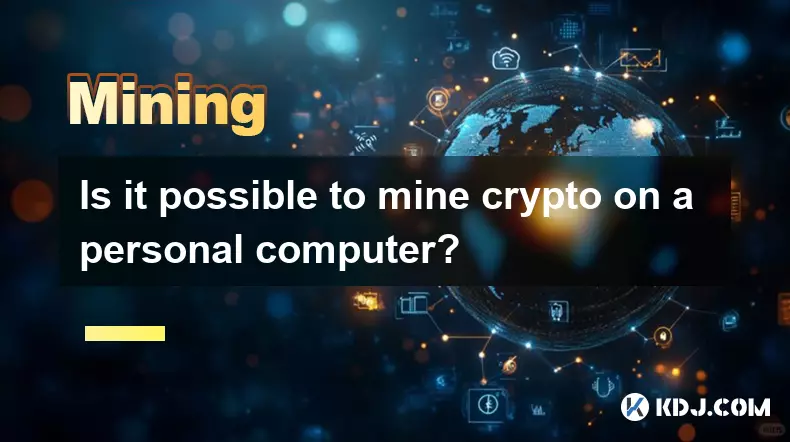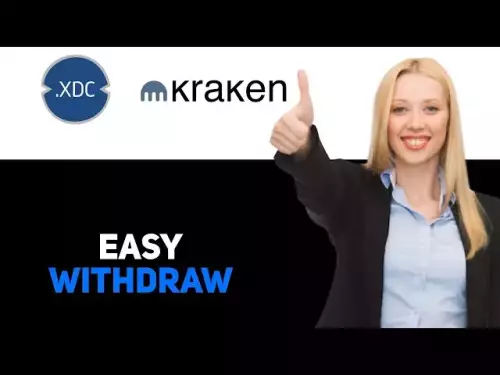-
 bitcoin
bitcoin $114684.631706 USD
-0.87% -
 ethereum
ethereum $4228.677447 USD
1.58% -
 bnb
bnb $1294.880693 USD
-1.16% -
 tether
tether $1.000819 USD
-0.02% -
 xrp
xrp $2.605138 USD
2.79% -
 solana
solana $209.908690 USD
5.89% -
 usd-coin
usd-coin $0.999903 USD
-0.03% -
 dogecoin
dogecoin $0.213423 USD
2.93% -
 tron
tron $0.322721 USD
-0.10% -
 cardano
cardano $0.727247 USD
3.66% -
 hyperliquid
hyperliquid $42.339456 USD
6.05% -
 chainlink
chainlink $19.910811 USD
5.16% -
 ethena-usde
ethena-usde $1.000557 USD
0.00% -
 stellar
stellar $0.349734 USD
2.69% -
 bitcoin-cash
bitcoin-cash $543.848687 USD
-0.21%
Is it possible to mine crypto on a personal computer?
Yes, you can mine cryptocurrency on a PC, but due to high electricity costs and competition from specialized hardware, profits are often minimal or negative.
Oct 14, 2025 at 08:18 pm

Can You Mine Cryptocurrency Using a Personal Computer?
1. Yes, it is technically possible to mine cryptocurrency on a personal computer. Early in the history of Bitcoin, individuals commonly used their home desktops to validate transactions and earn rewards through proof-of-work mechanisms. CPUs and later GPUs were sufficient for handling the computational demands at that time.
2. However, as blockchain networks grew, mining difficulty increased exponentially. Modern mining operations now rely on specialized hardware known as ASICs (Application-Specific Integrated Circuits), which outperform general-purpose PCs by orders of magnitude. These machines are designed solely for mining and dominate networks like Bitcoin’s.
3. Mining profitability depends heavily on electricity costs, hardware efficiency, and the current market value of the coin being mined. A typical personal computer consumes significant power relative to its output, making it unlikely to generate positive returns after accounting for utility expenses.
4. Some alternative cryptocurrencies still support GPU mining, where consumer-grade graphics cards can contribute meaningfully. Coins such as Monero or Ethereum Classic have algorithms resistant to ASIC dominance, allowing individuals with capable PCs to participate in decentralized mining pools.
5. Running mining software on a personal machine can lead to overheating, reduced hardware lifespan, and higher energy bills. Users must carefully monitor system temperatures and ensure adequate cooling to prevent damage.
Popular Cryptocurrencies Mined on Consumer Hardware
1. Monero (XMR) uses the RandomX algorithm, optimized for standard CPUs. It intentionally resists ASIC mining to promote decentralization, making it one of the few viable options for personal computers.
2. Ravencoin (RVN) employs the KawPow algorithm, which favors GPU miners and discourages ASICs. Enthusiasts with high-end graphics cards often include this in their mining rotation.
3. Ethereum Classic (ETC) continues to use Ethash, a memory-hard algorithm that allows GPU-based mining. While less profitable than before, it remains accessible to those with compatible rigs.
4. Vertcoin and Zcash also offer varying degrees of accessibility for non-ASIC setups, though returns are modest and highly dependent on local electricity pricing.
5. Joining a mining pool increases the chances of earning consistent payouts, even with limited computing power. Pools combine resources from multiple miners and distribute rewards proportionally based on contributed work.
Risks and Considerations for PC Miners
1. Continuous full-load operation stresses components, particularly the GPU and power supply. This accelerates wear and may void manufacturer warranties.
2. High electricity consumption can offset any potential earnings, especially in regions with expensive power rates. A miner must calculate break-even points before investing time and energy.
3. Malware disguised as mining software is prevalent. Untrusted downloads can infect systems, turning them into part of botnets without the user's knowledge.
4. Operating systems may throttle performance under sustained loads, reducing efficiency. Proper configuration of BIOS settings, voltage limits, and fan curves is essential for stability.
5. Network congestion and fluctuating coin values impact revenue unpredictably. Sudden drops in price or spikes in difficulty can render a previously marginal setup completely unprofitable overnight.
Frequently Asked Questions
Q: What software do I need to start mining on my PC?A: Popular mining applications include XMRig for Monero, T-Rex or GMiner for GPU-based coins, and CGMiner for more advanced configurations. Always download from official repositories to avoid compromised versions.
Q: Does mining damage my computer?A: Extended periods of maximum workload generate heat and strain internal components. Without proper ventilation and maintenance, thermal degradation can shorten the lifespan of your GPU, CPU, and motherboard.
Q: Can I mine while using my computer normally?A: Mining consumes nearly all available processing power, leading to severe slowdowns during regular tasks. Most users dedicate separate machines or run miners during idle hours to balance usability and output.
Q: Is solo mining feasible on a personal computer?A: Solo mining requires solving entire blocks independently, which is extremely unlikely without massive computational resources. For home users, joining a shared pool is the only practical method to receive regular rewards.
Disclaimer:info@kdj.com
The information provided is not trading advice. kdj.com does not assume any responsibility for any investments made based on the information provided in this article. Cryptocurrencies are highly volatile and it is highly recommended that you invest with caution after thorough research!
If you believe that the content used on this website infringes your copyright, please contact us immediately (info@kdj.com) and we will delete it promptly.
- XRP Price Prediction: Weekend Rollercoaster or Rally?
- 2025-10-12 08:45:16
- Bittensor (TAO): Super Bullish Signals Point to Potential 2x Rally
- 2025-10-11 10:25:12
- Silver Price Correction: Navigating the Dip & Identifying Key SEO Keywords
- 2025-10-11 10:25:12
- Decoding Crypto Trends: Bittensor's Bull Run, Cardano's Dip, and LivLive's Presale Buzz in 'Uptober 2025'
- 2025-10-12 08:45:16
- MoonBull: The Crypto Meme Coin Promising 1000x Gains?
- 2025-10-11 10:30:01
- Crypto Payroll Revolution: Stablecoins, Altcoins, and the Future of Salary Payments
- 2025-10-11 10:30:01
Related knowledge

Is it possible to mine crypto on a personal computer?
Oct 14,2025 at 08:18pm
Can You Mine Cryptocurrency Using a Personal Computer?1. Yes, it is technically possible to mine cryptocurrency on a personal computer. Early in the h...

The difference between staking and mining
Sep 24,2025 at 05:18am
Understanding Staking in the Cryptocurrency Ecosystem1. Staking involves holding funds in a cryptocurrency wallet to support the operations of a block...

How to participate in testnet mining?
Sep 22,2025 at 09:18am
Understanding Testnet Mining in the Crypto Ecosystem1. Testnet mining is a method used by blockchain developers to simulate real-world conditions on a...

How to dispose of abandoned mining machines?
Sep 19,2025 at 08:19pm
Assessing the Condition of Abandoned Mining Rigs1. Begin by inspecting each mining machine for visible damage, corrosion, or missing components. Machi...

How to identify high-quality mining pools?
Sep 21,2025 at 03:19pm
Reputation and Track Record1. A mining pool’s reputation is built over time through consistent performance and transparency. Pools that have operated ...

Advantages of decentralized mining pools
Sep 20,2025 at 04:36pm
Enhanced Security and Resistance to Censorship1. Decentralized mining pools operate on blockchain-based smart contracts, eliminating the need for a ce...

Is it possible to mine crypto on a personal computer?
Oct 14,2025 at 08:18pm
Can You Mine Cryptocurrency Using a Personal Computer?1. Yes, it is technically possible to mine cryptocurrency on a personal computer. Early in the h...

The difference between staking and mining
Sep 24,2025 at 05:18am
Understanding Staking in the Cryptocurrency Ecosystem1. Staking involves holding funds in a cryptocurrency wallet to support the operations of a block...

How to participate in testnet mining?
Sep 22,2025 at 09:18am
Understanding Testnet Mining in the Crypto Ecosystem1. Testnet mining is a method used by blockchain developers to simulate real-world conditions on a...

How to dispose of abandoned mining machines?
Sep 19,2025 at 08:19pm
Assessing the Condition of Abandoned Mining Rigs1. Begin by inspecting each mining machine for visible damage, corrosion, or missing components. Machi...

How to identify high-quality mining pools?
Sep 21,2025 at 03:19pm
Reputation and Track Record1. A mining pool’s reputation is built over time through consistent performance and transparency. Pools that have operated ...

Advantages of decentralized mining pools
Sep 20,2025 at 04:36pm
Enhanced Security and Resistance to Censorship1. Decentralized mining pools operate on blockchain-based smart contracts, eliminating the need for a ce...
See all articles

























![[4K 60fps] Prisma by novichokk (1 Coin) [4K 60fps] Prisma by novichokk (1 Coin)](/uploads/2025/10/14/cryptocurrencies-news/videos/k-fps-prisma-novichokk-coin/68ee49804ba00_image_500_375.webp)
















































